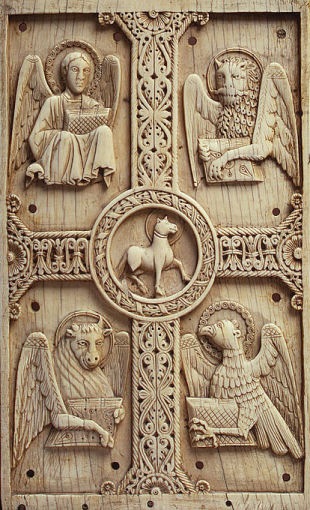The Veracity and Harmony of
the Four Gospels
The Synoptic and St John's Gospels
 The
following essay does not demonstrate that the four
Gospels are ‘inspired’ or the ‘Word
of God’. Indeed, it is nonsense to start
a faith journey with such an unreasonable assertion
of blind faith. The purpose is far more pedestrian,
merely to establish that the New Testament in general,
and the Gospels in particular, are reliable history.
The
following essay does not demonstrate that the four
Gospels are ‘inspired’ or the ‘Word
of God’. Indeed, it is nonsense to start
a faith journey with such an unreasonable assertion
of blind faith. The purpose is far more pedestrian,
merely to establish that the New Testament in general,
and the Gospels in particular, are reliable history.
Early Roman and Pagan Witnesses
Just one example among several: Tacitus,
a Roman historian, writing in about 116 AD (the equivalent
of a modern historian writing about the First World War)
mentions Christians, and explains that the founder of
this sect, Christ, had been executed by the Roman procurator,
Pontius Pilate, during the reign of Tiberius. Clearly
for Tacitus, an historian living but a few decades after
Christ, Christ was an actual historical person who had
founded a religious sect and whose fate was simply an
accepted fact of recent history.
A First-Century Jewish Witness
Flavius Josephus,
a Jewish historian, published a lengthy history of the
Jews in the year 93. While discussing the period
in which Judea was governed by the Roman
procurator Pontius Pilate, Josephus includes the following
account: “About this time there lived Jesus, a
wise man, if indeed one ought to call him a man. For
he was one who performed surprising deeds and was a teacher
of such people as accept the truth gladly. He won over
many Jews and many of the Greeks. He was the Messiah.
And when, upon the accusation of the principal men among
us, Pilate had condemned him to a cross, those who had
first come to love him did not cease. He appeared to
them spending a third day restored to life, for the prophets
of God had foretold these things and a thousand other
marvels about him. And the tribe of the Christians, so
called after him, has still to this day not disappeared.” (Jewish
Antiquities, 18.3.3 §63)
Christian Witnesses
St. Justin, writing to the Roman Emperor
Antoninus Pius around 150 AD, after narrating the facts
concerning the death of Christ, then suggests to the
emperor that he might substantiate these facts for himself
by consulting the official archives of the Roman Empire: “…...
That all this really happened as I have described it,
Your Majesty can read for yourself, in the official annals
compiled under Pontius Pilate ...”
The Four Gospel Writers
Interesting and important as the above
witness and others may be, the most significant and abundant
evidence for the life of Christ in the first century
comes from the New Testament writers, especially the
four Gospel writers: Matthew, Mark, Luke and John, but
also St Paul and others.
Are the four Gospels actually
written by the men to whom they are attributed?
In examining the manuscript rolls of
the four Gospels, the names of four authors: Matthew,
Mark, Luke and John are found. Both manuscript
and historical evidence justify the conclusion that the
authors of the four Gospels are actually the men to whom
they are attributed.
Historians are aware of over four thousand
manuscripts from the period up to the ninth century.
We have Greek, Latin, Coptic and Syriac manuscripts,
manuscripts from every corner of the Roman Empire. Among
these the Rylands Papyrus, preserved in the Manchester
Library, contains some verses of chapter 18 of the Gospel
of St. John, dating back to the first half of the second
century. Not one of those manuscripts suggests
any author other than the four attributed by antiquity. Such
unanimity is probably unique. This unanimity is
further collaborated by the testimony of the early fathers
of the Church, including men intimate with the Apostles.
An internal examination of the Gospels also permits no
other conclusion.
Are the Gospels as we read them
today the same texts that came from the pens of the
Evangelists who wrote them?
In the question of integrity, just
as in the question of authenticity, the Gospels again
enjoy a privileged position.
Modern scholars have undertaken the painstaking work
of comparative examinations of the various manuscripts
to attempt to reconstruct the original. The objection
might be raised that they have discovered an enormous
number of variants. True. However, none
of these variants touches the essential part of the text. Amiot
[L’Evangile, p.450] sums it up thus: “In
the totality of manuscripts, citations from the Fathers
prior to the fourth century, and ancient versions, there
are some 250,000 variants. The greater part of these
are insignificant, since they concern only the spelling
and order of words. According to Hort, seven-eighths
of the text is beyond discussion. The variants that would
change the text are only a thousandth part of the text
itself; only about fifteen have any real importance;
not one of them touches on the substance of any dogma…..”
Where the Apostles writing fact,
not fiction?
The truthfulness of the evangelists
can hardly be called into question. It is a fundamental
canon of historical criticism that no one lies without
a reason, and the evangelists certainly had no reason
to lie.
Prior to following Christ, most of
the Apostles were what one today might call middle-class. John
and Peter were members of small family fishing businesses,
established enough to be able to afford hired-help. Luke
was a physician. Matthew was a wealthy man, employed
in the lucrative Roman financial sector.
In preaching Christ they could expect
only persecution, poverty, dishonour and death. They
were considered scandalous traitors to their own nation
because they preached a Messiah who spelled the end of
Israel’s dreams of political restoration. The
pagans looked on them as fools (1 Cor. 1:23). A passage
from St. Paul’s second letter to the Corinthians
tells of what he had to suffer in preaching the Gospel
(2 Cor.11:16.33).
Matthew
Matthew recounts that, before following
Christ, he was a publican. ‘Publican’ in
the Gospels signifies an employee of one of the Roman
financial companies who ‘franchised’ the
tax collecting for the Roman occupiers. Because
of the Jewish hatred of the Roman occupancy, Jews who
served their foreign masters were understandably objects
of hatred. Perhaps a better translation today would
be ‘quisling’
Matthew recounts his call to follow
Jesus (Matthew 9:9-13), which took place about five months
after Christ began his public ministry. From then
on Matthew remains one of Christ’s closest companions.
Most probably Matthew composed his Gospel in Aramaic
around the year 50. The original Aramaic text, however,
has not survived. It was translated and reworked into
Greek between the years 65-70 AD.
Mark
Mark was the cousin of St Barnabas
(Col., 4:10) who was a disciple of the original “inner” twelve. Showing
his affectionate regard for a younger man, St. Peter,
the prince of the Apostles, calls Mark his son (I Peter
5:13). It was to Mark’s mother’s house
that St Peter turned on his escape from prison in 42
AD.
Mark subsequently worked with of St
Peter and St. Paul, at Rome. Early writers record that
Mark had been the interpreter and scribe of St Peter,
and further that he wrote down accurately the teaching
of Peter. Mark’s Gospel was probably written in
its present form around the year 65, after the martyrdom
of St Peter.
Luke
Luke was not a Jew. His style
proves that he was a Greek. He was a physician
by profession. St. Luke is a painter in words and
the most accomplished of all the New Testament writers. He
was the companion and helper of St Paul and remained
with St Paul even during his final imprisonment and martyrdom
in Rome.
In the prologue to his Gospel, Luke
says that he had taken great pains to inform himself
of his material, from those who had been ministers of
the Gospel from the very beginning.
On account of the breadth of the field
covered by his writings, very few writers have ever had
their accuracy put to such a severe test as St. Luke. Sir
William Ramsay, a noted scholar of the first-century
Near East, writing in the 1930s concluded that Luke was
a first-rate historian; and points out that in references
to thirty-two countries, fifty-four cities and nine islands,
Luke does not make one single mistake. Luke’s
Gospel was written probably between 60-70 AD.
John
John was the son of Zebedee and Salome.
Salome was one of the women who discovered the empty
tomb. John’s brother, James, was also an Apostle.
The Gospel records that the two brothers were given by
Christ the nickname “Sons of Thunder” (Mark
3:17). Originally they were fishermen and fished with
their father in the Lake of Genesareth. They were called
by Christ to discipleship (Matt. 4:18-22) about five
months after the start of Christ’s public ministry.
John from then on had a prominent position
in the Apostolic body. John alone remained near his beloved
Master at the foot of the Cross on Calvary with the Mother
of Jesus and the pious women. He took the desolate Mother
into his care as the last legacy of Christ (John 19:25-27).
According to tradition, apart from
Judas who took his own life, John was the only Apostle
who wasn’t martyred. He died at an advanced
age in what is now Turkey, his Gospel being the last
to be written. At the end of his Gospel he states explicitly
that he has written what he has actually seen and that
his testimony is true (John 21:24).
The apostle John narrated events of
which he had clearly been an eye-witness: “When
they came to Jesus, they found he was already dead, and
so instead of breaking his legs one of the soldiers pierced
his side with a lance; and immediately there came out
blood and water. This is the evidence of one who saw
it - trustworthy evidence, and he knows that he speaks
the truth …..” (John 19:33-35)
Conclusion
Of the four gospel writers, two were
Apostles who were with Christ almost daily for the best
part of three years, one was the constant companion and
scribe of Peter, the Prince of the Apostles, and one
was a gifted historian who spent his adult life in the
company of the Apostles. There can be few events
in history that can call four more reliable witnesses
to the stand.
The Gospels are historical books, the
most historical books of antiquity, and their truthfulness
was sealed with the blood of their authors.
This essay is based on, THE GOSPELS - Historical
and True, a work of Domenico Grasso SJ, Professor
of Pastoral Theology at the Gregorian University,
Rome. Available
from Faith – Keyway
Publications.
